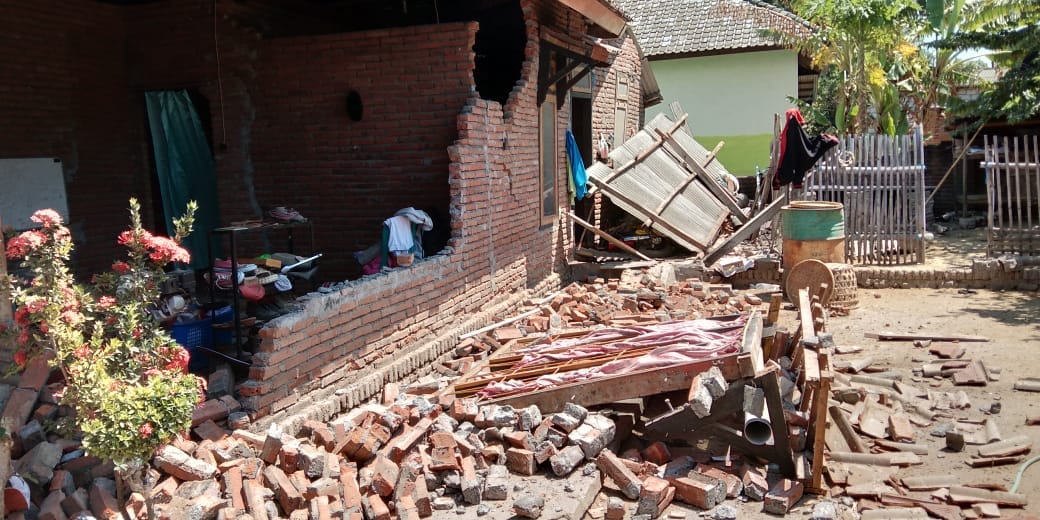
LOMBOK, INDONESIA (AFP, REUTERS, XINHUA) - Multiple earthquakes – including a powerful and shallow 6.9-magnitude tremor – struck Indonesia’s Lombok on Sunday (Aug 19), killing at least two people and sending fresh panic coursing through the already battered island.
A series of quakes were recorded by seismologists throughout Sunday, the first measuring 6.3 shortly before midday which triggered landslides and sent people fleeing for cover.
It was followed nearly 12 hours later by a late evening quake measuring 6.9 and at least five more significant aftershocks, according to the US Geological Survey.
The picturesque island is already reeling from two devastating quakes on July 29 and August 5 that killed nearly 500 people and made hundreds of thousands homeless.
National disaster agency spokesman Sutopo Purwo Nugroho said two people were killed by the quake late Sunday evening, one in eastern Lombok and the other on the neighbouring island of Sumbawa.
“Two people died... from falling debris and many houses collapsed because of the 7-magnitude earthquake,” he said on Twitter, giving a slightly higher local measurement for the largest quake.
Blackouts had hit much of Lombok, he added, posting pictures of cracked roads and video footage of a large fire that broke out in a village on Sumbawa.
A sleeping local resident said the powerful tremor jolted him awake. “The earthquake was incredibly strong. Everything was shaking,” Agus Salim told AFP.
“We were all sleeping in an evacuation tent. I had just fallen asleep when suddenly it started to shake... Everyone ran into the street screaming and crying.” The area was hit by a power blackout, he added.
There were no immediate reports of deaths or injuries from Sunday's earlier tremor.
“The earthquake caused people to panic and flee their houses,” national disaster agency spokesman Sutopo Purwo Nugroho told Metro TV after the tremor.
He added that activity on the island was normal and landslides were reported in a national park where hundreds of hikers had been trapped on a volcano after a quake in late July, adding that Mount Rinjani was closed and there were no tourists there.
Local disaster mitigation agency spokesman Agung Pramuja said several houses and other structures in the district of Sembalun, on the slopes of Mount Rinjani, collapsed on Sunday after being damaged by the previous two quakes.
The structures included checkpoints once used by trekkers climbing the mountain, Pramuja said, adding that the exact number of damaged buildings was still being checked.
Residents said Sunday's earlier earthquake was felt strongly in East Lombok.
East Lombok resident Augus Salim told AFP: “I was driving to deliver aid to evacuees when suddenly the electricity pole was swaying. I realised it was an earthquake.
“People started to scream and cry. They all ran to the street.”
The tremor was also felt in the island’s capital Mataram and on the neighbouring resort island of Bali.
“It was very strong. All the lights went out,” Asmaatul Husna told Reuters at a Mataram shopping mall where she works.
“Everybody ran outside their house. They’re all gathering in an open field, still terrified,” said Endri Susanto, a children rights activist in Mataram.
“People are traumatised by the previous earthquakes and aftershocks never seem to stop.”
The quake comes two weeks after a shallow 6.9-magnitude quake on Aug 5 levelled tens of thousands of homes, mosques and businesses across Lombok.
More than 480 people died and tens of thousands were injured.
The hardest hit region was in the north of the island. A week before that quake another tremor surged through the island and killed 17.
The Aug 5 quake left more than 350,000 displaced with many sleeping under tents or tarpaulins near their ruined homes or in evacuation shelters, while makeshift medical facilities were set up to treat the injured.
Badly damaged roads, particularly in the mountainous north of the island, have created a headache for relief agencies trying to distribute aid.
The economic toll of the quake – including its impact to buildings, infrastructure and productivity – has been estimated to be at least 5 trillion rupiah (S$470 million).
Dubbed “The Island of a Thousand Mosques”, Muslim-majority Lombok is a less popular destination than its neighbour Bali, the Hindu-majority island that forms the backbone of Indonesia’s US$19.4 billion tourist sector.
But Lombok had been earmarked as one of Indonesian President Joko Widodo’s “10 new Balis” with the regional government hoping to develop it into a major destination, especially in the booming halal tourism sector.
Indonesia, an archipelago of thousands of islands, sits on the so-called Pacific “Ring of Fire”, where tectonic plates collide and many of the world’s volcanic eruptions and earthquakes occur.
In 2004, a tsunami triggered by a 9.3-magnitude undersea earthquake off the coast of Sumatra, in western Indonesia, killed 220,000 people in countries around the Indian Ocean, including 168,000 in Indonesia.

